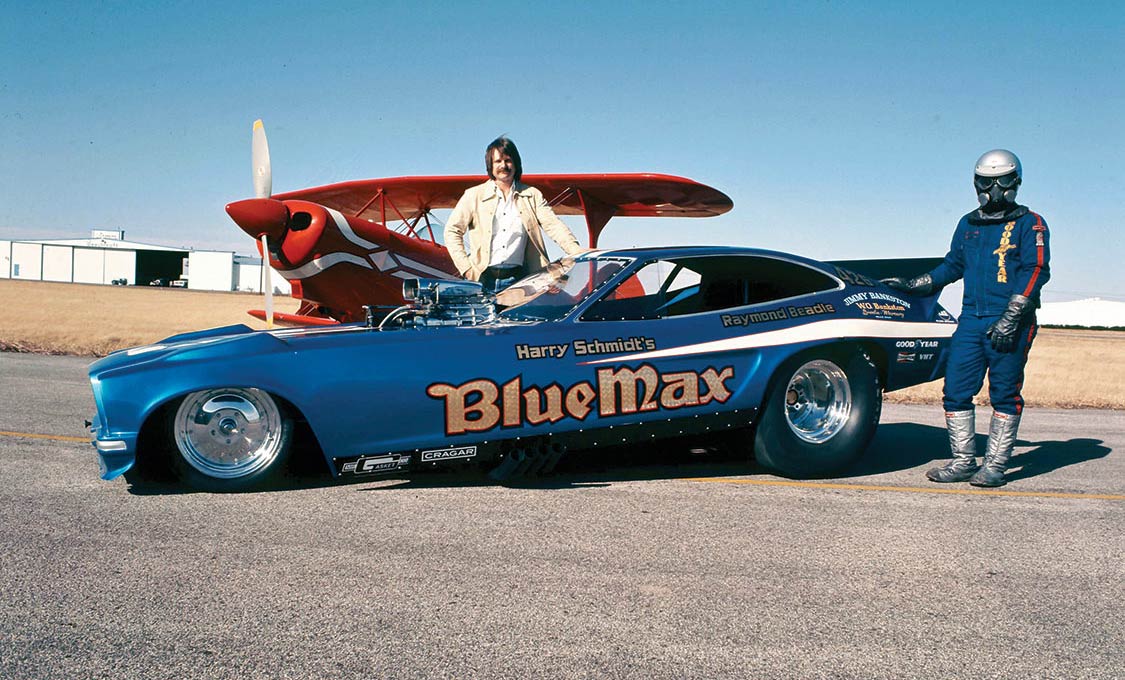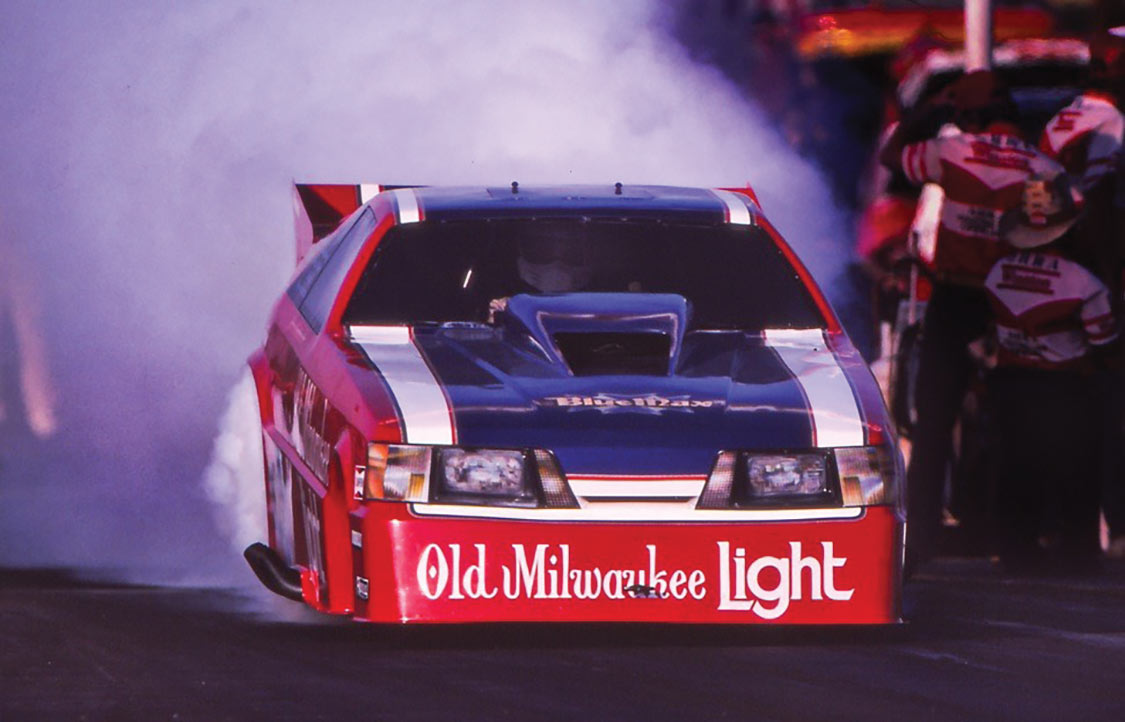ALAN PARADISE September 29, 2022 All Feature Vehicles

If you could put together the positive attributes of the most successful Funny Car drivers in NHRA history—the intuitive nature of Jack Chrisman, the toughness of Don Prudhomme, the marketing genius of Tom McEwen, the showmanship of Tommy Ivo, the popularity of Jim Liberman and the media savvy of John Force—you’d create a man named Raymond Beadle.
Beadle’s career, although seemingly condensed into a few decades of racing, was an intense span that netted him more than 30 national titles, a legion of fans and the respect of every driver, team owner, track manager, sponsor and journalist.

The path from the tiny Texas town of Spur to the very pinnacle of the motorsports world, on the surface, seems common for the era. However, the manner in which Beadle attacked every aspect of racing was nothing short of amazing.
During the formative days of drag racing, Beadle’s small town surroundings were less than ideal for the love of speed. It’s tough to race traffic light to traffic light in a town that doesn’t even have a traffic light. Nearby Dickens wasn’t much better, but head west to Lubbock and now you had something. The land of Buddy Holly offered more than a legacy of rock ’n’ roll, it supplied a foray into horsepower.
It has always been said that automotive trends begin in California, are quickly adapted and flavored in Florida, and then migrate to the rest of the country. The lone exception to that formula has always been Texas. Texas has always marched to its own tune. That held true to racing and the colorful cast of characters it has produced. None coming from the Lone Star State was as charismatic as Raymond Beadle. He used this natural ability to great advantage and quickly climbed the drag racing ladder.

With a quick wit, infectious laugh and movie star smile, Beadle charmed his way onto the A-list. His unique, natural driving ability and aptitude to understand the subtle technical nuances of the sport earned him the opportunities to jump from doorslammers to Top Fuel dragsters in a very short period of time. His regional success continued to mount, as did his popularity. However, as the ’60s were coming to an end, so was Top Fuel as the sport’s top draw. Funny Cars had become the fan favorite, and when McEwen and Prudhomme scored the history-changing Mattel Hot Wheels deal, Beadle had no intention of being left in the flip-top wake.
In 1971, Beadle landed a ride in the Stud Mustang, a former Gas Rhonda Funny Car. He cut his teeth in the older chassis until his efforts led to a seat in fellow Texan “Big Mike” Burkhart’s Vega-bodied Funny in ’72. That didn’t last long as Don Schumacher scooped up the fast Texan to pilot one of his Stardust Vegas, and later, the Continental Baking Company’s Wonder (Bread) Wagons. This provided Beadle the means to tour with one of the premier drag racing teams of the day. The lessons learned and contacts made would be of great benefit to the likable Texan. The most notable and ultimately important association was Harry Schmidt.
During the formative years of Funny Cars, fellow Texan Harry Schmidt was a talented tuner. He proved his worth as the wrench for the Friendly Chevrolet Nova and Camaro driven by Mike Burkhart.

During the formative years of Funny Cars, fellow Texan Harry Schmidt was a talented tuner. He proved his worth as the wrench for the Friendly Chevrolet Nova and Camaro driven by Mike Burkhart. After a short break from the sport, Schmidt fielded his own ’69 Mustang Funny with power supplied by Ramchargers Racing Engines. It was about this time that the movie “The Blue Max,” starring George Peppard, was a box office hit. Schmidt loved the idea of the character as well as the Blue Max logo. Coupled with his German heritage and the trend of every Funny Car driver grabbing a nickname, he came up with the idea of naming his team after the film. After blowing through a number of potential drivers, Richard Tharp won the full-time job. The Blue Max then joined many of the sport’s other Funny Car teams on extended match race and national event tours.
After three seasons on the road, most as long as 40 weeks per year, Schmidt was beat up and longed for his Dallas homeland. He parked the Blue Max at the end of 1972. In the summer of 1974, Schmidt grew restless and Schumacher persuaded him to come on board his team. With Schmidt and Beadle both having Lone Star roots, the two became close friends.

It was during the summer of 1974 that Beadle approached Schmidt with the idea of bringing back the Blue Max Funny Car name. By this time Beadle had wisely developed an extensive Rolodex of factory reps, track managers, sponsors, media contacts and equipment suppliers. After the NHRA U.S. Nationals, Beadle and Schmidt formed their own enterprise. A few months later, Beadle was piloting a new Beadle and Schmidt Blue Max Mustang II.
With the romantic image of the Blue Max, the tuning talent of Schmidt, and the charismatic personality of Beadle, the Blue Max team became one of the most popular on the circuit. As important to the success of the team as Beadle’s driving ability was his track presence. His relationship with the fans was as good as it gets, a lesson he learned by watching Tom “The Mongoo$e” McEwen, who was the undisputed master of the sport. Beadle never just signed autographs; he always took time to speak to each fan, even if it was only a few words. This endeared him to fans and, in turn, connected those fans with the Blue Max and all of its sponsors.
His second venture shocked the racing world. In 1983, Beadle went stock car racing, not as a driver, but as a team owner.

Beadle and Schmidt had a very successful 1974 season, which included beating the nearly unstoppable Prudhomme piloting his Army Monza to win the U.S. Nationals. Following that season, Schmidt, physically and mentally exhausted from the racing grind, informed Beadle he was retiring, leaving him with the option to buy the Blue Max team. High from his biggest win, Beadle extended himself financially and purchased Schmidt’s half of the operation. From that point on, it was all on Beadle, and although he had never run his own operation, he soon created what would be the blueprint for drag racing success. The blend of good-natured westerner and charming racer could instantly be transformed into that of a dead serious businessman. He was savvy in the boardroom and knew how to market the Blue Max into a formidable brand.
From 1974 to 1978, no driver in the sport was as dominant on the track as Prudhomme. He was about as unbeatable as drag racing had ever seen. But, in terms of branding, Beadle had taken the marketing ideals pioneered by McEwen and Prudhomme to a new level. He understood that branding was the key element to consistent sponsorships. As the Prudhomme garnered all of the titles, Beadle was inching closer on the track but jumping ahead in merchandising. While many drivers had their cars in die-cast and model kit form (including the Blue Max), Beadle started merchandising items at the track. Shirts, hats, models, decals, posters and cups were available to fans onsite, a practice that’s common now but had its roots with Beadle.

In 1979, Beadle’s killer instinct on the track kicked into overdrive. For the next three years, tuned by the inimitable Dale Emory and crewed by “Waterbed Fred” Miller and D Gantt, he was the number one driver, winning the NHRA Funny Car championship for three straight years. He also dominated the IHRA circuit, nabbing championships in 1975, 1976 and 1981.
With a head for business and a thirst for success, Beadle ventured into two new directions. He started Chaparral Trailers, units specifically designed to accommodate the unique needs of race teams. The name became synonymous with the sport as the trailer of choice for serious racers.
His second venture shocked the racing world. In 1983, Beadle went stock car racing, not as a driver, but as a team owner. He tapped Tim Richmond to be the first of three drivers for Blue Max Racing. Richmond finished the season in the Top 10 including a win in Pocono. When Richmond left for Hendrick Motorsports in 1986, Beadle took a chance on a young gun named Rusty Wallace. The payoff came in 1989 when Beadle and Wallace took the Blue Max Racing team to the pinnacle of the sport and the Winston Cup crown.

Just because there was a Blue Max on the big ovals it didn’t mean that Beadle put drag racing on the back burner. It did, however, split his attention, which resulted in only one national win (Springnationals) in 1983 and two titles in 1984 at Englishtown and Denver. He brought on veteran “Lil’” John Lombardo to drive in 1985 and 1986, and he took one final round at the wheel in 1987.
In an odd twist of irony, as Beadle and Wallace were in the heat of a NASCAR season, the Blue Max Funny Car, the roots of Raymond’s racing fame and where he had the most success, made its final pass driven by Ronny Young.
Loyalty in racing can often be an oxymoron. When Wallace abandoned Beadle for Penske Racing in 1991, Blue Max Racing not only lost its driver, but the sponsorship with Miller Beer went with the driver. Beadle was more than angry; he became disillusioned with NASCAR racing. He created a World of Outlaw team, piloted by sprint car legend Sammy Swindell, but soon closed that after a few seasons.
The horse ranch he built to enjoy during racing’s short off-season was calling. He retired to West Texas to focus on his many business interests.

By 1995, the good old days of drag racing were gone as well. The sport had transformed from a touring affair to a points chase. Gone were the days of match races and having fun while you run. There was less and less camaraderie and experimentation. It was semis, hospitality tents and sponsorship courting. The days of wrenching had become filled with formulas and computer technology. It had become an eerie reminder of the taste of NASCAR. Beadle knew he could adapt and thrive in the “new” NHRA, but the desire was not there. He thought about his old friend Harry Schmidt. He now longed for the joys of a simpler, slower life, about his Texas roots in a town with a population of 500. The horse ranch he built to enjoy during racing’s short off-season was calling. He retired to West Texas to focus on his many business interests as well as trying his hand at cattle ranching. He found a quieter success outside racing’s limelight that became just as satisfying.

The NHRA honored Raymond Beadle as number 20 of the top drivers of all time. He collected 13 NHRA national event titles, made it to 28 final rounds and won three world championships. What he did in the pits was just as impressive: developing a legion of fans with his engaging personality and pioneering approach to merchandising the Blue Max image he so deeply loved.